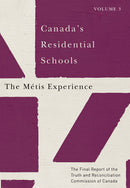Description
Canada's Residential Schools: The Metis Experience, Volume 3 addresses topics that are often ignored in the discussion of residential schooling. This title is part of The Final Report of the Truth and Reconciliation Commission of Canada. Constant changes in government policy meant that, at some times, Metis children were barred from residential schools, while, at other times, residential schools were the only schools that would accept Metis children. The Métis Experience focuses on an often-overlooked element of Canada’s residential school history. Canada’s residential school system was a partnership between the federal government and the churches. Since the churches wished to convert as many Aboriginal children as possible, they had no objection to admitting Métis children. At Saint-Paul-des-Métis in Alberta, Roman Catholic missionaries established a residential school specifically for Métis children in the early twentieth century, while the Anglicans opened hostels for Métis children in the Yukon in the 1920s and the 1950s. The federal government policy on providing schooling to Métis children was subject to constant change. It viewed the Métis as members of the ‘dangerous classes,’ whom the residential schools were intended to civilize and assimilate. This view led to the adoption of policies that allowed for the admission of Métis children at various times. However, from a jurisdictional perspective, the federal government believed that the responsibility for educating and assimilating Métis people lay with provincial and territorial governments. When this view dominated, Indian agents were often instructed to remove Métis children from residential schools. Because provincial and territorial governments were reluctant to provide services to Métis people, many Métis parents who wished to see their children educated in schools had no option but to try to have them accepted into a residential school. As provincial governments slowly began to provide increased educational services to Métis students after the Second World War, Métis children lived in residences and residential schools that were either run or funded by provincial governments.


